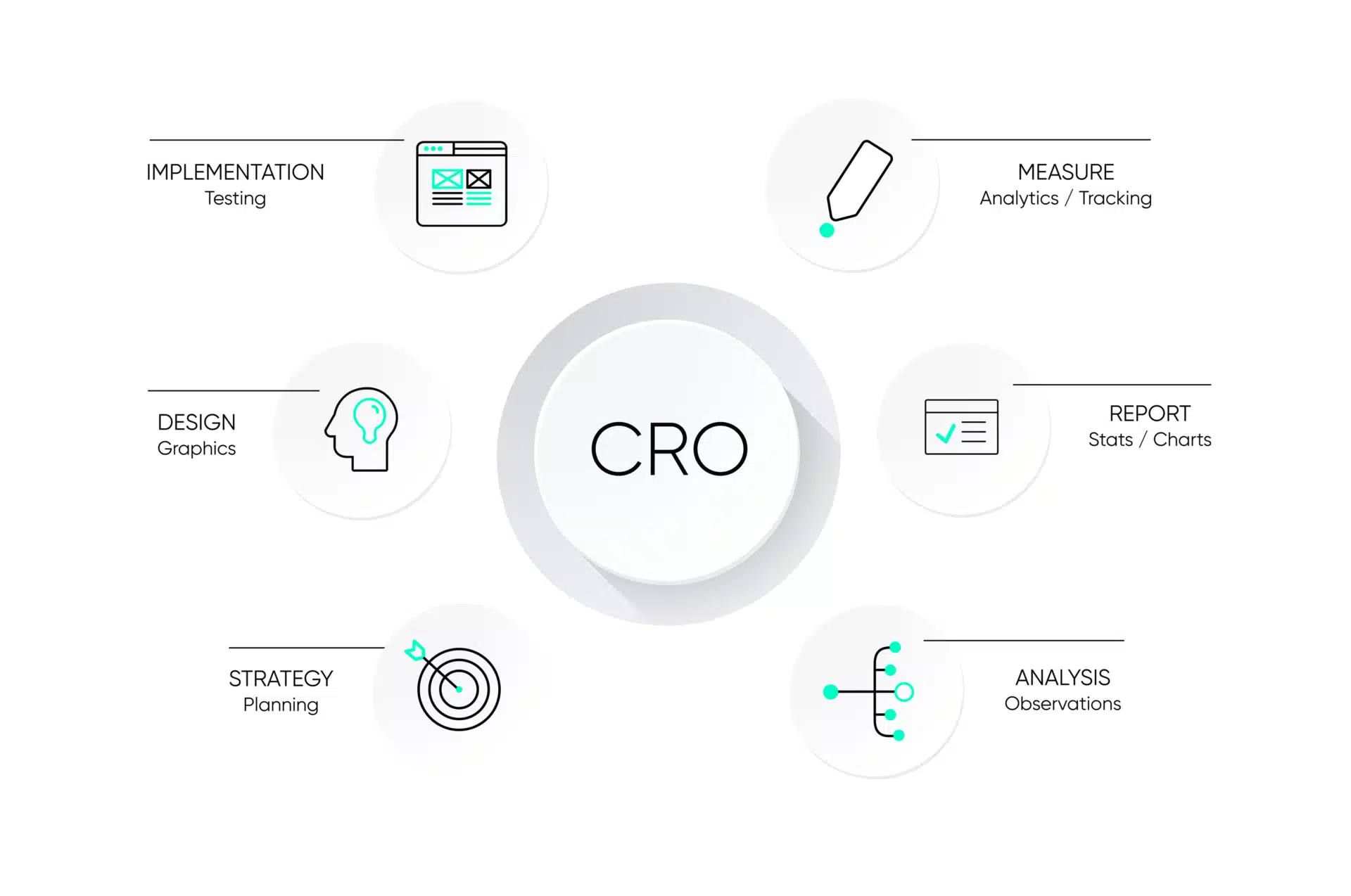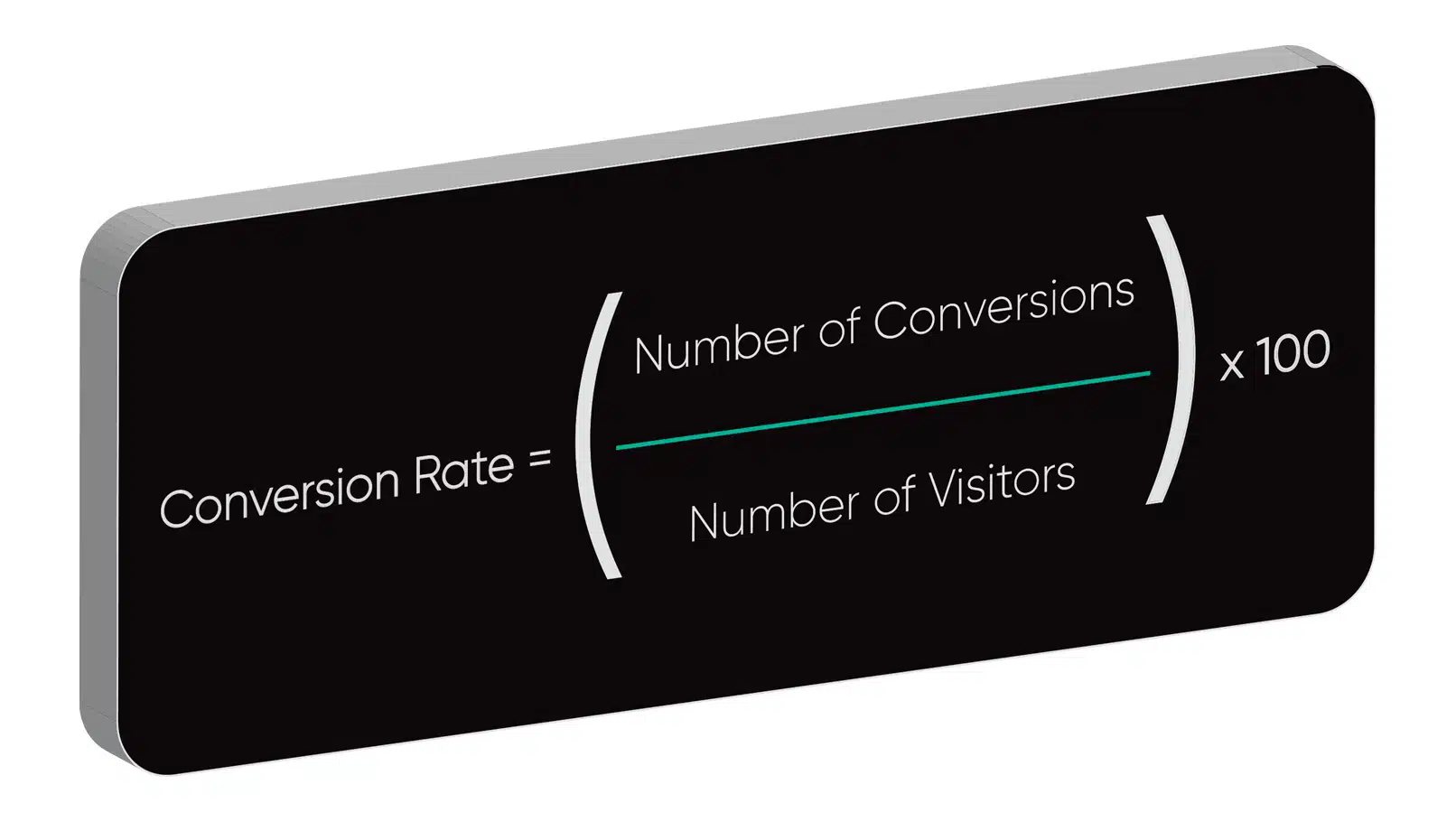With over 170 new websites created every minute, more than the mere presence of your digital platform is needed. It is required to deliver a seamless journey for your visitors, set you apart, and create online business opportunities. Conversion Rate Optimisation (CRO) defines a strategy where design, content and strategic placement of elements converge to elevate your website into a conversion powerhouse, transforming casual visitors into customers.
Search Engine Optimisation (SEO) and CRO work symbiotically to improve revenue, considering every visitor not just a statistic but a potential conversion waiting to happen.
What is Conversion Rate Optimisation (CRO)?
Conversion Rate Optimisation (CRO) is the systematic process of increasing the number of website visitors who take action with a desired conversion, like filling out a form, becoming a subscriber, purchasing a product or service or other defined conversion events. This is managed by improving awareness, delivering more visits and ensuring that your website provides a seamless experience once the user lands on your site. Conversion Rate Optimisation (CRO) is the strategic key that unlocks this potential by fine-tuning your website’s design, content, and functionality and enlisting specific techniques and strategies to enhance your customer’s experience and increase the likelihood of converting.

Defining and Calculating Conversion Rates
Conversion rate is one of the most fundamental metrics in digital marketing and e-commerce. They represent the percentage of website visitors who complete the desired action. Understanding and calculating conversion rates is critical to assessing the effectiveness of a website and its marketing strategy.
Conversion rates can vary greatly depending on the type of action and industry involved. E-commerce websites might measure their conversion rate by the percentage of visitors who complete a purchase. Meanwhile, a new business generation website may focus on form submissions. Other examples include the visitor adding items to the shopping cart, starting to subscribe to a mailing list, creating an account, downloading an app or clicking on an affiliate link.
To calculate the conversion rate, the following formula is used:

What is the Relationship between SEO and CRO?
Search Engine Optimisation (SEO) and Conversion Rate Optimisation (CRO) are interconnected components of online marketing. SEO focuses on improving a website’s visibility in search engine results, while CRO aims to improve user experience and drive conversions.
When SEO is done effectively, it can increase the amount and quality of website traffic. But traffic alone does not guarantee conversions. CRO is used to optimise the user experience and ensure that visitors take the desired actions of the website.
For example, CRO strategies generally focus on improving page load times, increasing mobile responsiveness, and creating compelling call-to-action buttons. All these actions not only improve the user experience but also contribute to higher conversion rates.
Strategies for Conversion Rate Optimisation
A successful CRO is based on a set of fundamental principles and strategies. A/B testing is essential for comparing two web page versions to determine which performs better at creating more conversions.
- User experience (UX) design also plays a critical role in CRO. A well-designed website with a logical navigation structure and clear action buttons can significantly improve the chances of conversion. Simplifying the process will enhance the likelihood.
- Content optimisation involves creating compelling and informative content that leads visitors to specific conversion points, such as high-quality images, product descriptions, and blog posts. These can all contribute to better conversion rates.
- Mobile optimisation is another key aspect of CRO. As more and more users browse and shop on mobile devices, ensuring your website is mobile-friendly to capture mobile traffic is crucial. Also, while search engines adapt to AI and language models, CRO and SEO must evolve to include diverse and adaptive content designed to create a particular experience for each user. Examples of these techniques are on e-commerce websites that present items according to previous purchases, geolocation or personal preferences.
Which Tools can I use to create a successful CRO Strategy?
In 2025, many tools are available to help you implement a successful CRO Strategy. These tools are based on data analytics, A/B testing, and user feedback and engagement. These are some examples:
Google Analytics(GA4)
Google Analytics 4 is a must-have tool in the industry. Free to use, it offers comprehensive insights about website traffic, performance, user behaviour, demographics, etc. This tool helps us track the KPIs (Key Performance Indicators). Using GA4, we can understand how the user interacts with our website, and using this data, we can improve the strategy using informed decisions that align with the user’s requirements.
VWO
To implement a successful CRO Strategy, it is necessary to perform A/B Testing. VWO allows us to create tests such as A/B, Multivariate and Split URLs, allowing us to experiment with different versions of our website’s components and content, providing us with crucial insights to understand which elements generate the best results within our target audience.
Hotjar
We can use this tool to get behaviour analytics and user feedback tools, visualising how the user interacts and moves around our website. Using Hotjar, we can visualise heatmaps and create session recordings, surveys, and more, all aimed at giving us the information we need to locate the action elements in the places where the user’s attention goes and allocating additional information or a call to action before the user abandons our site.
Optimizely
This is a powerful experimentation platform that allows us to create and test personalised user experiences, including elements such as layouts, content, design and more. We can use Optimizely to implement changes, use the information from the test, measure these changes, and refine our CRO Strategy.
To create a successful CRO Strategy, having the correct information and creating changes based on data and experimentation is crucial. This is why, using these tools, we can provide a global view of our strategy and continuously improve and adapt accordingly. CRO is evolving, as it is also the user behaviour, trends and devices used to interact with our web applications, and we must always stay up-to-date and aware of these changes.

Conversion Rate optimisation for E-commerce
For e-commerce websites, CRO has a significant meaning. Conversion Rate Optimisation strategies for e-commerce are adapted to product pages, shopping carts and checkout processes.
Product pages should provide detailed product information, high-resolution images, and user reviews to build trust and facilitate purchase decisions.
Clear and compelling product descriptions can make a significant difference in conversion rates.
Optimising the shopping cart means facilitating the purchase process. In other words, this provides alternative solutions to make it as easy as possible for the shopper – for instance, guest checkout, using security markings and offering several payment options. The checkout process should be streamlined and user-friendly. Progress meters, auto-fill forms and easy-to-read error messages can all help reduce the number of people who don’t complete their purchases. Still, CRO can also help create a call to action for customers who abandoned the cart using personal messages, dedicated advertisements, or email marketing.
International Conversion Rate Optimisation for E-commerce
Expanding into international markets requires additional considerations for CROs. Cultural nuances, linguistic factors and currencies can affect conversion rates. Hence, CRO strategies for international e-commerce should include tailoring the content, currency options and payment methods to accommodate regional preferences.
For example, an e-commerce platform targeting the US and European markets may need to offer prices in dollars and euros, provide locally adapted content and design, consider specific taxes involved, and region-specific shipping options.
Conversion Rate Optimisation for Local Businesses
Local businesses can significantly benefit from CRO strategies tailored to their geographic area. Local SEO is critical in driving traffic and conversions for companies with a brick-and-mortar presence.
Optimising for local SEO means ensuring accurate business listings, collecting customer reviews, and creating location-specific content. In particular, customer reviews can increase trust and credibility, leading to higher conversion rates.
A study by BrightLocal found that 87% of consumers read online reviews for local businesses, highlighting the importance of managing and leveraging reviews for CROs in local SEO. For example, a well-optimised Google My Business page with contact information, pictures, products and reviews is optimal to improve CRO for a local business.
Best Practices in Conversion Rate Optimisation
To be successful with CRO, it is essential to follow specific guidelines; some of the key principles include:
- Test: Continually A/B test to improve different parts of the website to identify what works best for your target audience.
- Use data: Use data analytics to gain insights into user behaviour and identify areas for improvement.
- Optimise for Mobile: Prioritise mobile optimisation to cover the growing number of mobile users.
- Be consistent: Keep a clear and compelling customer promise to convince visitors to convert.
- Improve Tracking: Optimise your website’s events tracking and triggers using Google Analytics 4 and other statistical tools.
- Keep learning: Stay up-to-date on the latest CRO tools and resources.
YOU CAN CHECK OUR EXPANDED LIST OF RECOMMENDATIONS BELOW
Conversion Rate Optimisation Services
Many companies turn to professional CRO services to maximise their conversion potential. These services offer expertise and tools to identify and implement optimisation opportunities effectively.
To choose the right CRO service provider, it is important to consider factors such as experience, past performance and the specific needs of your business.
Webbiz offers innovative solutions with advanced analysis and state-of-the-art techniques that optimise conversions and drive business growth.
Our many years of experience and multicultural team with diverse backgrounds help us understand countless scenarios and create successful solutions for many industries.
6 Essential Elements for Conversion Rate Optimisation
Measurement and Analysis
A fundamental part of CRO is using data to understand how visitors interact with your website. Using tools like Google Analytics, you can track visitor behaviour, see which pages have the highest conversion rate and identify where visitors deviate. By analysing this information, you can decide which areas must be optimised.
User testing
User testing is a critical component of CRO. Having actual users interact with your website lets you gain insights into their experience and identify any barriers to conversion. User testing can be conducted by asking users to perform specific tasks on your website while observing their reactions and the feedback provided.
Multivariate/B/Split Testing
In addition to A/B testing, multivariate and B/split testing can help you test multiple changes simultaneously and identify the most effective combination. This is useful when optimising multiple elements on a page, such as headlines, images, and CTA buttons. Tools like Optimizely and VWO (Visual Website Optimizer) can help you conduct such tests.
Psychology and Behavioral Sciences
An understanding of psychology and behavioural science is essential in CRO. It’s about understanding why visitors act in a certain way and using this insight to create a more compelling user experience. Concepts like social proof, immediacy, and trust building are essential in convincing visitors to convert.
Segmentation and Personalisation
Understanding your target audience and segmenting visitors based on their behaviour and preferences are important strategies in CRO. By tailoring your website and messaging to the visitor’s profile, you can increase relevance and the likelihood of conversion. Dynamic content and personalisation techniques can help you execute this strategy effectively.
Social media has a direct impact on CRO. By creating engaging and shareable content on your pages, you can increase the spread of your website and attract new visitors. Shareable buttons and social sharing incentives can encourage visitors to share your content and increase exposure.
The Future of Conversion Rate Optimisation
As the digital world continues to evolve, CROs are also expected to do so. With the growth of AI and machine learning, CRO processes may become more automated and data-driven. Predictive analytics can empower businesses to influence their visitors’ behaviour by strategically providing the layout and content with more possibilities to generate conversions based on the extracted data.
Mobile devices will likely continue to be a major focus in CRO, with more users using smartphones and tablets to access websites and make purchases. Effective design and mobile optimisation strategies will be critical to maximising conversions on these platforms.
Last, user privacy and data protection will be a central issue within CRO. With stricter regulations such as GDPR (General Data Protection Regulation) in Europe and increased awareness of privacy issues, companies must be careful about collecting and using user data. Transparent communication and clear privacy policies will build trust and maintain conversion rates.
Conversion Rate Optimisation Significantly Impacts Success
In conclusion, Conversion Rate Optimisation is a tool that significantly impacts the success of websites and businesses. It is not limited to e-commerce but applies to all online businesses, including local businesses.
Understanding conversion rates and implementing effective CRO strategies is highly technical and time-consuming. Therefore, Webbiz can help with its expert knowledge in local SEO, making a significant difference to your online success.
